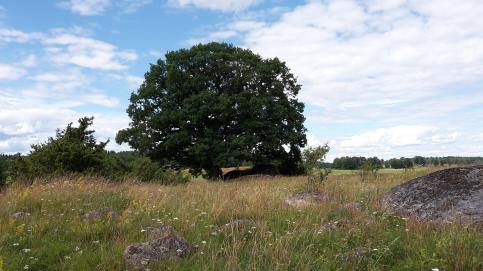Background

Sweden and other north European countries have changed their way of keeping lifestock during the last 100 years. As a result of this many grazing animals are now grazing closer to the farms because it is more economically sustainable. Because of abandoned areas, more and more pastures have changed by succession from short-grown dominant vegetation to dense mixed forests with a lot of trees competing for sunlight. These changes from open areas to dense mixed forest is a problem for many trees, and oaks are no exception.
Overgrowing is one of the main reason why the oak populations have declined in northern Europe and Sweden last 100 years. One way to preserve the oaks is called conservation thinning. The method is simple, competing trees are cut down to increase the available light. Oaks can adapt to changes in availble light levels (if it is not to shady so the oak can not produce enough of energy) by growing different leaves in the sunny and shady parts of the tree. The shade-leaves are generally bigger, thinner, have fewer stomatas and lighter compare with sun-leaves. Oaks who are living in shady environments have lower vitality and a higher percentage of shady-leaves compare to oaks that are living in sunny environments. Even if oaks has been thinned, it is not sure that the oaks growth and vitality benefit after the thinning.
By adapt to the surroundings, it is possible for the oak to optimize the essential processes (photosynthesis rate etcetera) which the oak needs to survive. But if the surroundings are too overgrown, the oak cannot adapt and will consequently die. Partial thinning is therefore one way to increase the available light levels and therefore create opportunities for the oak to adapt to light levels where they can survive during the time which oaks need to adapt. It is import when these thinnings are completed. Studies have found that buds of beech (Fagus sylvatica) have adapted to different light levels by the end of July. It means according to same author that thinning or other conservation procedures performed after beginning of august have small or no effect on the leaf adaptations the next season. Some oaks are dying even if conservation thinning has increased the light levels. It can be both because of that too less biomass has been cut down around the oak and because too much biomass has been cut down. It is not possible for oaks to adapt if that is too radical changes in their surroundings.
Aims
The aim with this study is to investigate if oaks can adapt to new light conditions the first year after a conservation action or if they need several years for adaptation. This is done by comparing typical leaf morphological parameters from oaks from three different managements (formerly thinned, recently thinned and unmanaged areas). Another aim with this study is to study how the explanatory variables are affecting the response variables and how all these variables are related to each other.
Responsible for this page:
Director of undergraduate studies Biology
Last updated:
05/21/19
